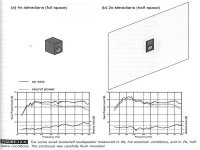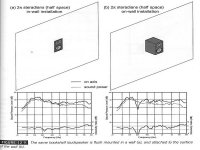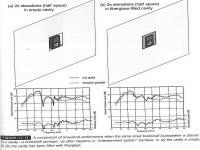I have a dedicated AV/hifi room and have previously built a pair of subwoofers and was thinking about another project.
I'm thinking of going from a 5.1 speakers system to a 7.1 speaker system so need two more surround speakers.
My AV room which i treated acoustically with 6 X 1800mm X 600mm acoustic rock wool filled panels to deaden the room a little....this got me thinking?
I saw at a local dealer some PMC wafer speakers (a hang on the wall flatish panel speaker about 4 inch in depth) which seemed expensive at over a £1000 each, so I thought I could build something similar but build them into a acoustic panel, so all you would see is acoustic panels but the rear acoustic panels would have a surround speaker build in.
The PMC are a transmission Line design and apparently have a H frame inside to direct the bass to the port, how would I start to design one and pick drivers etc? Any problems or ideas?
I'm thinking of going from a 5.1 speakers system to a 7.1 speaker system so need two more surround speakers.
My AV room which i treated acoustically with 6 X 1800mm X 600mm acoustic rock wool filled panels to deaden the room a little....this got me thinking?
I saw at a local dealer some PMC wafer speakers (a hang on the wall flatish panel speaker about 4 inch in depth) which seemed expensive at over a £1000 each, so I thought I could build something similar but build them into a acoustic panel, so all you would see is acoustic panels but the rear acoustic panels would have a surround speaker build in.
The PMC are a transmission Line design and apparently have a H frame inside to direct the bass to the port, how would I start to design one and pick drivers etc? Any problems or ideas?
Is your crossover going to be passive or active? Do you have measuring gear and software to model a crossover?
If you don't have measuring gear and knowledge to design a crossover then some component speakers designed for cars would probably be your best bet. You don't have to worry about BSC in a car, so the crossover should work. The only problem I can see is modeling the low frequency response.
If you don't have measuring gear and knowledge to design a crossover then some component speakers designed for cars would probably be your best bet. You don't have to worry about BSC in a car, so the crossover should work. The only problem I can see is modeling the low frequency response.
Last edited:
Hi thanks I wanted to build something a bit better than some car drivers in a box. I have REW and UMIK-1 mic. Is there no tried and tested designs which I could adapt to fit the space I have? Keep the same internal volume but change the dimensions to fit into a 1800mm X 600mm acoustic panel thanks
It can take years to get your first passive crossover any good.
I think a fullrange driver may be a better idea. This thread looks like it could be perfect for your needs - Ever think of building a Cornu Spiral horn? Now you can!
I think a fullrange driver may be a better idea. This thread looks like it could be perfect for your needs - Ever think of building a Cornu Spiral horn? Now you can!
If you think you are capable of designing the xo, perhaps with some help, I would probably be looking at some of the low profile drivers out there, like:
Peerless GBS135
Dayton LW150
For surround speakers, both will go below 100Hz in a sealed box which simplifies things. Depending on your SPL requirements, you may want to double up and go MTM with the woofers wired in series for an 8ohm load to help minimize cone excursion. The Peerless 5" has a nice advantage in the sensitivity department over the 6" Dayton but it also has a rising response in the low frequencies which will need some attention.
Peerless GBS135
Dayton LW150
For surround speakers, both will go below 100Hz in a sealed box which simplifies things. Depending on your SPL requirements, you may want to double up and go MTM with the woofers wired in series for an 8ohm load to help minimize cone excursion. The Peerless 5" has a nice advantage in the sensitivity department over the 6" Dayton but it also has a rising response in the low frequencies which will need some attention.
nks for all your replies.
I have Kef reference 2 for my main speakers and the Kef reference 200 for a centre.
What would happen if I bought another 2 Kef reference 200 speakers second hand, worked out the internal volume of the cabinet and made another cabinet with same volume but a different shape? a flat box and ported it with same size port? Also use the crossover from the centre?
Is it possible to just get any second hand speaker and change the shape of the cabinet but keep the same internal volume ? Would it work as the original speaker?
In a ported speaker what happens when you change the internal volume?
Could you use Even a pair of Kef reference model 1 s with the single uni q driver?
I have Kef reference 2 for my main speakers and the Kef reference 200 for a centre.
What would happen if I bought another 2 Kef reference 200 speakers second hand, worked out the internal volume of the cabinet and made another cabinet with same volume but a different shape? a flat box and ported it with same size port? Also use the crossover from the centre?
Is it possible to just get any second hand speaker and change the shape of the cabinet but keep the same internal volume ? Would it work as the original speaker?
In a ported speaker what happens when you change the internal volume?
Could you use Even a pair of Kef reference model 1 s with the single uni q driver?
Last edited:
These 2 links may shed some light on your questions:
Loudspeaker Spacial Loading
Loudspeaker Diffraction Loss (you can probably ignore the compensation part)
Attached are a few more diagrams that may help as well.
Both the port tuning frequency and the SPL from the port are altered by changing the box volume. If the driver will go down to about 80Hz or below in a sealed box, that may be the better option for surround speakers.
Now if you have a decent AVR and are happy with it's eq app, you may (stress the word, may) be happy just using that to compensate for any changes to the FR with a 'normal' speaker.
Loudspeaker Spacial Loading
Loudspeaker Diffraction Loss (you can probably ignore the compensation part)
Attached are a few more diagrams that may help as well.
Both the port tuning frequency and the SPL from the port are altered by changing the box volume. If the driver will go down to about 80Hz or below in a sealed box, that may be the better option for surround speakers.
Now if you have a decent AVR and are happy with it's eq app, you may (stress the word, may) be happy just using that to compensate for any changes to the FR with a 'normal' speaker.
Attachments
If you take a freestanding speaker, and move the components to a very wide flat baffle that is nearly flush with a wall, you'll get more midbass response*, so you'd ideally add some eq or tweak the original crossover (or both).Is it possible to just get any second hand speaker and change the shape of the cabinet but keep the same internal volume ? Would it work as the original speaker?
IMO, with the mic you have + a small selection of crossover parts to play with, you can mess about with attenuation and low order crossovers without needing to be a genius.
*look up threads about "baffle step compensation" and The Edge (the simulator).
I don't have a lot of experience with the newer receivers out these day, so others may be able to add more, but with what I have used the more eq points the app has the better.
Currently I'm using a Marantz that just gives 1 eq point every octave between 63Hz and 1600Hz, so 9 points in total which doesn't really allow for much fine tuning. For eg, it eq's at 2000Hz and 4000Hz but if you want to fix something at 3000Hz, you are kind of out of luck.
For your purposes using a retail speaker, I'd be looking for something better than that. But if you still want to change it into something the same depth as an acoustic panel, you may still be in trouble if the speaker you choose has a midwoofer that is too deep to start off with. With eq, you might still want to consider putting a design together with a low profile driver and a simmed xo. The eq should be able to fix any shortcomings in the design, if they exist, and you should be able to get the low profile design you were originally thinking of.
Currently I'm using a Marantz that just gives 1 eq point every octave between 63Hz and 1600Hz, so 9 points in total which doesn't really allow for much fine tuning. For eg, it eq's at 2000Hz and 4000Hz but if you want to fix something at 3000Hz, you are kind of out of luck.
For your purposes using a retail speaker, I'd be looking for something better than that. But if you still want to change it into something the same depth as an acoustic panel, you may still be in trouble if the speaker you choose has a midwoofer that is too deep to start off with. With eq, you might still want to consider putting a design together with a low profile driver and a simmed xo. The eq should be able to fix any shortcomings in the design, if they exist, and you should be able to get the low profile design you were originally thinking of.
No offense, however this thread is a bit misguided. If you want to build a quality set of loudspeakers of your own design that will compete with the current technology requires a considerable amount of self education. I strongly suggest one of three options. One, have a thorough read of a sight, namely Troels Gravesen.dk is a good example of what it takes. A second option, and this is what i'd suggest, is to build one of his designs. Or thirdly, have a look at Q Acoustics (Im aware this i sacrilege on a DIY site, however they have a flat response and low distortion for cheap, which is no mean task). The first option however can be a very rewarding hobby and fun hobby to undertake. Parts Express. com has a good measurement system i.e. Dayton Omnimic. Hope this helps.
- Status
- This old topic is closed. If you want to reopen this topic, contact a moderator using the "Report Post" button.
- Home
- Loudspeakers
- Multi-Way
- Where do I start? Pmc wafer cloneish!


